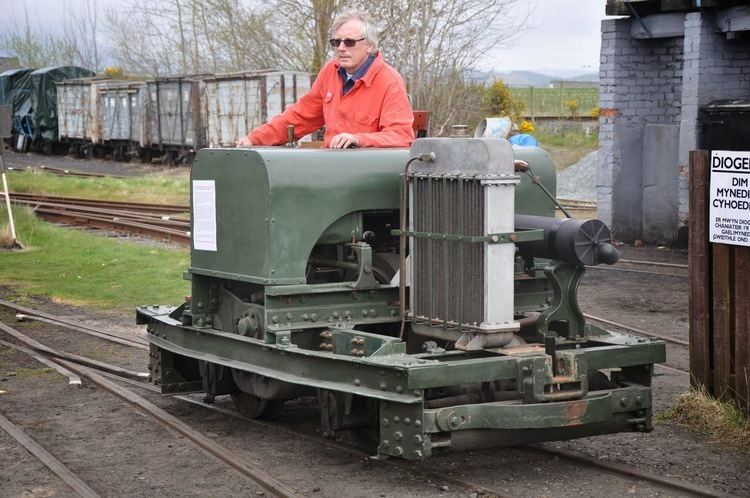Founders George Gale, John Abbott | ||
 | ||
Motor Rail was a British locomotive-building company, originally based in Lewes, Sussex they moved in 1916 to Bedford. In 1987 loco manufacture ceased, and the business line sold to Alan Keef Ltd of Ross-on-Wye, who continue to provide spares and have built several locos to Motor Rail designs.
Contents
History
The origins of the Motor Rail company can be traced back to the patenting of a gearbox by John Dixon Abbott of Eastbourne in 1909 ("Change speed and reversing gearbox suitable for use in motor-trams", Uk Patent 18314). In March 1911, he formed The Motor Rail & Tramcar Co Ltd, with his father John Abbott and brother Tom Dixon Abbott. The stated aim of the business was developing the gearbox and incorporating it in tramcars and railcars. At about the same time operations moved to Lewes, Sussex and rented space in the Phoenix Foundry of John Every where they developed a narrow-gauge rail vehicle around the Dixon-Abbott gearbox using a twin cylinder water-cooled Dorman engine.
In January 1916, the company answered a War Department tender for military supply railways. The specification was for a 600 mm (1 ft 11 5⁄8 in) gauge locomotive, with no more than 1 ton of axle load per axle, capable of hauling up to 15 tons at 5 miles per hour (8.0 km/h). The company designed a new locomotive, with outer longitudinal "bent-rail" frame, mounted on two driven axles. The 2JO petrol engine manufactured by W.H.Dorman & Co of Stafford was centre-set in the frame along with its Dixon-Abbott patent gearbox, which drove the unsprung axles through a chain-drive. At one end of the frame the operator sat facing to one side allowing him to drive equally well in either direction, and at the other end was the silencer and the water cooling radiator mounted with fan to provide transverse air flow. A large flywheel gave relatively smooth operation.
After approval by the War Department of the prototype, a small order was placed for evaluation in France. Success here led to significant orders and as a result the company moved to new premisies in Houghton Rd, Bedford in May 1916. John Abbott died in August 1916, and John Dixon Abbott took over as chairman.
A second but armoured version was made to a specification defined by the Ministry of Munitions. This used an upgraded Dorman 4JO 40HP engine and two speed gearbox, coming in three versions:
The Dorman engine used by Motor Rail from the earliest days was reported in 1918 to have been "designed by Mr Abbott, in conjunction with W.H. Dorman Ltd of Stafford", which could explain why the company exclusively used this engine. The same article states that the WW1 production of the Dixon-Abbott gearbox was contracted out to David Brown Ltd. of Huddersfield.
With over 900 such locomotives supplied to the WD and MoM, post-WW1 the resultantly large and cheap supply of these trench tractors opened up the use of internal combustion engine powered locomotives to many new and existing applications, where steam engines were either too heavy, too expensive or allowed cheaper operations. The company had found its niche, and continued to build petrol and diesel-engined locomotives, mainly for narrow gauge railways.
In 1931 the company changed its name from Motor Rail & Tram Car Co to Motor Rail Ltd. The trade name Simplex was registered in 1953, though the name Simplex was in use by the company as early as 1915. In 1972 the company was renamed Simplex Mechanical Handling Ltd.
Other Products
In the early stage of its development the Motor Rail & Tram Car Company was involved in developing self-propelled tramcars, though the extent of production is not clear. In 1915 The Engineer magazine reported on the Simplex Rail Coach made in Lewes with the Brush Company building the body, delivered to the South Indian Railway Company where it was expected to be run on the Pamban Viaduct line. The coach weighed 12 tons, would carry 70 people, and was powered by a four-cylinder Dorman petrol engine rated at 45 bhp. The tram car part of the company name was dropped in 1931, so it is presumed there was no tram car part of the business beyond this date.
In 1919 Motor Rail manufactured some standard gauge inspection cars for the Ministry of Munitions, and the testing of these cars on the branch line between Bedford and Hitchin was reported in The Engineer. The cars were powered by the two cylinder Dorman engine with Dixon-Abbott 2-speed gearbox, and averaged over 30 mph on the test, and reached 43 mph. One of the cars was run on paraffin, though it was intended they would be run on petrol. They were lightweight at only 3.25 tons, though could carry up to 2 tons payload if required. The seating being easily removable to offer load space.
In 1939 Motor Rail introduced the Motor Rail Dumper - a 4-ton, 2-wheel-drive dump truck (running on tyres rather than rails). It again used the Dorman engine, and a variant of the Dixon-Abbot gearbox. At least one survives. According to a 1955 advert, the diesel engine dumper had a capacity of 3 cubic yards, and had six forward gears and two reverse. It would carry a load of 4 tons up a 1 in 5 gradient. It was available with front control (driver at the front facing forward), or rear control (driver looking over the load, and hence with rear wheel steering, as is common modern practice).
Preserved locomotives
Many Motor Rail products survive in preservation, and they are probably the most common make of narrow gauge locomotive still in existence in the United Kingdom.
Heritage railways with Motor Rail locomotives include:
